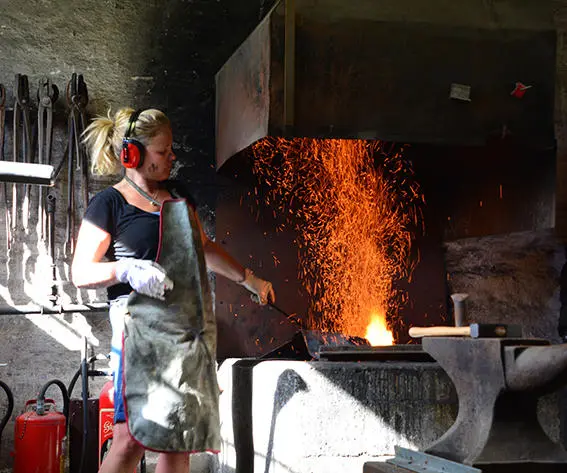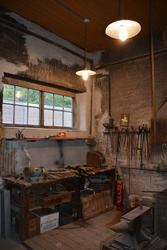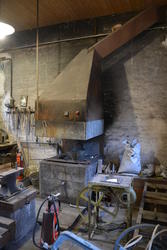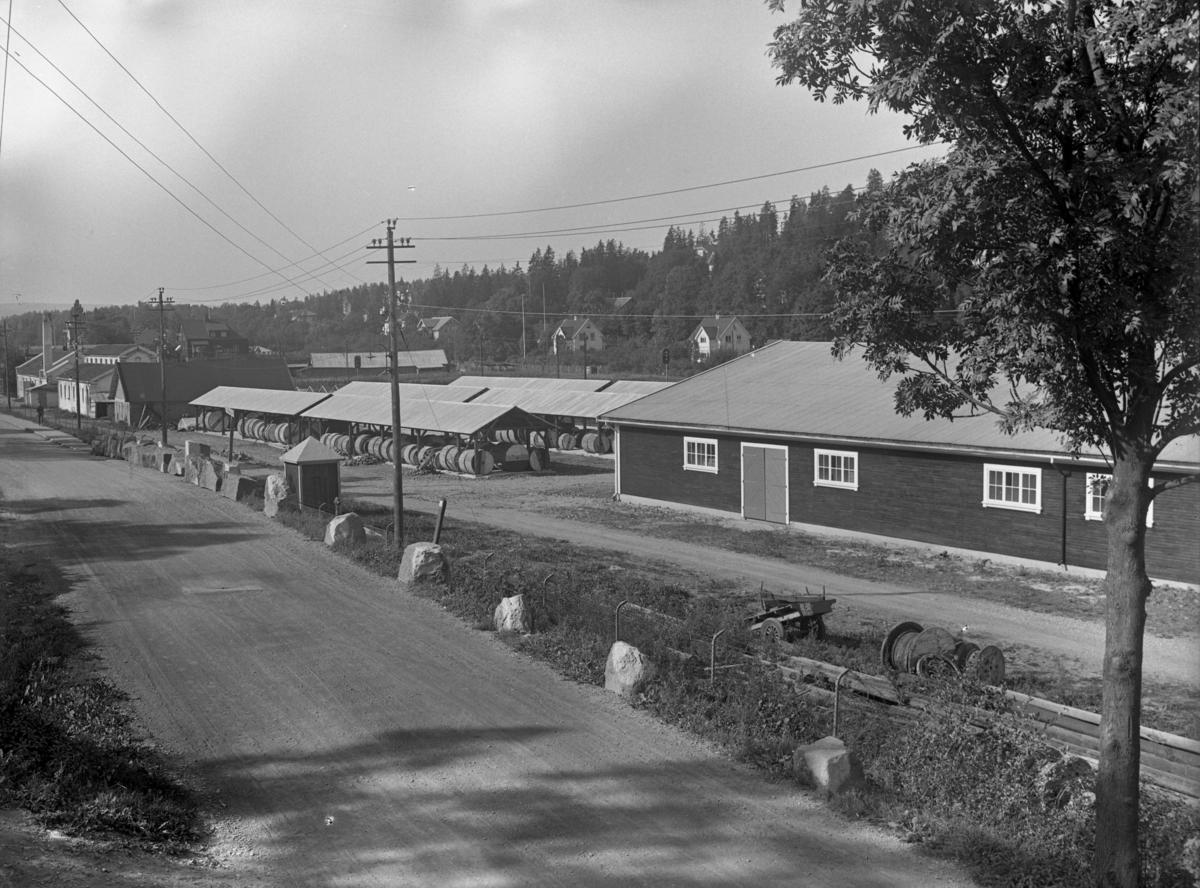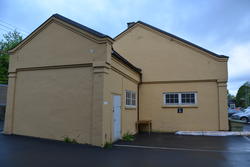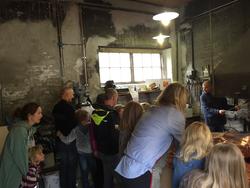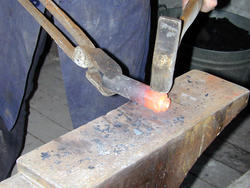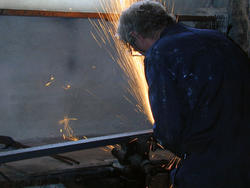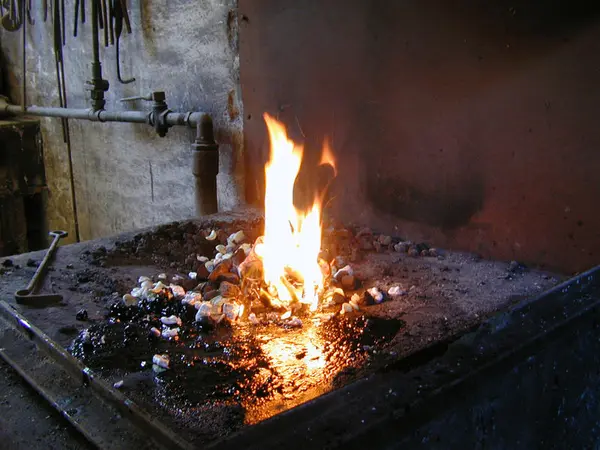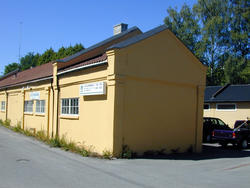-
Metal artist Therese Mathiesen Stein Domaas/Telemuseet
-So this is where I work, says Therese Mathiesen, and opens a rickety plank door leading into the smithy. It is at the end of a yellow brick building from around 1900 next to a parking lot and a fairly new old people’s home. Even if it’s high under the ceiling in the smithy, the room seems constricting, almost grotto-like. The power is down due to redecoration, and triangles of daylight slip through two small-paned windows. The walls are dark. The soot around the forge stretches all the way up to the cornices, as if the history imbued in the walls have materialised and formed a decorative pattern covering the reddish brown bricks.
-The patina on the walls is absolutely stunning, says Therese, smiling.
-I like the rustic feel about it.
- 1/2
The smithers tools Stein Domaas/Telemuseet - 2/2
The smithers furnace Stein Domaas, Telemuseet
-
The smithy and surroundings at Stabekk, 1930ties Ukjent/Telemuseet
“One of a kind”
Rustic is a word that springs to mind, and authentic. Little has changed here since Telenor (Norges Telegrafvesen) took over Gamle Drammensvei 25 in 1924. The surrounding area, however, is completely different, tells Ivar-Magne Nydahl. He worked at Stabekk from 1966 to 1983, first as an errand boy at the auto repair shop, until he completed a fitter course in 1969. He reminisces of a time when the industrial estate was full of activity:
-Televerket owned an immensely large area, he says.
-All the way up to the sports field. There used to be an enormous storage space for splicing- and long distance cables where the old people’s home is situated today. Further, we had offices for the administration, an auto repair shop and two carpenter’s workshops. In these workshops, the fitter’s stools that we used while out splicing cables in the trenches were produced. There was also something we called “moffebua.” Inside an enclosure, dark, and grey with grime, they were turning led sleeves. These were fitted around splices to prevent water leakages.
-What about the smithy? What can you remember of it?
-Mainly, I remember it being a cold and dark area, laughs Ivar-Magne.
-Did you go there at all?
-Of course I stopped by there to have a chat with those who worked in the smithy, but as I say, it was very cold and dark in there. It wasn’t really a place to sit and talk. The place was very much marked by its lack of insulation in the walls. I’m in no doubt that the smiths would have had to endure a lot of cold days working in there.
He remembers one of the smiths particularly well.
-Sigurd Flåta was a very capable smith. His job was to produce tools and also to reshape worn out picks and spades.
-Did he work year round?
-Partly. At times, he would also work as a driver. At Stabekk we had large lorries that would transport cable reels in connection with, for instance, the re-routing of cables.
At most, 30- 40 people worked there, tells Ivar-Magne Nydahl. It was especially crowded in the winter time.
-Quite a few personnel came back from projects that had been stopped due to the cold.
The building which is left after the operations ended here, contained the administration, and later on, also showers and an exercise room tells Ivar-Magne. A corresponding building which used to contain a lubrication room, a welder’s workshop and a carwash, has been demolished. Only the smithy has been protected, due to being “one of kind.” That happened in 1997, and the question arose; what’s going to happen to the smithy now?
- 1/2
Smithy, exterior 2015 Stein Domaas/Telemuseet - 2/2
Smithy, exterior 2015 Stein Domaas/Telemuseet
Protection through use
One way of looking after cultural heritage is to use it. For the freshly graduated metal artist, Therese Mathiesen, it was a strike of good luck that her teacher at KHIO (Oslo National Academy of the Arts) had heard about the place. She contacted the Norwegian Telecom Museum.
-I needed a fireproof venue and an extractor, because I work with open fire. But who’s got a smithy sitting about? Therese smiles, and looks around the well-used work room.
-And then this fell into my lap. I’m incredibly grateful for the opportunity and that Telenor is thinking like they do.
There is a row of rusty tools hanging on the wall between the work bench and the forge.
-All of these are functional, but they’re too big for my needs, says Therese.
-So they are more or less for decoration only. But the anvil – (she’s patting an anvil which has been bolted down in the middle of the room) – is being used. An anvil never goes out of fashion.
The artist opens a cupboard under the work bench. It is jam-packed with rusty metal rods, and other smith’s equipment. Therese has not moved a thing since she took over in the summer of 2015. She has however added a few things of her own. In the middle of the room there is a sandbox filled with oil sand that she uses to shape her objects. There are also a couple of framed children’s drawings by the window, reminding us that this is yet again a living work space, even if it is a bit chilly. It is just October, but the wind is already blowing through the door. How can she work here in the depth of winter?
-I don’t, she says.
-It doesn’t matter how much wool underwear I put on, it’s just too cold in December and January.
The smithy is draughty with no insulation and with soot covering everything up to the chimney. Still, the first time Therese came here she immediately thought: “Yes! I can work here.”
-Well of course! There is something about everything stored in the walls here. The room has a particular atmosphere. The craft plied by the smiths that worked here is something I have taken further, to a different place, while I still work with a lot of the same materials, steel and metal.
-Do you feel a connection, when you’re standing here working?
-Not necessarily with Televerket, but I feel a connection to the work station, she says.
- 1/3
Smithy open to public Terje Norli/Telemuseet - 2/3
Red-hot iron Terje Norli/Telemuseet - 3/3
Smith in action Terje Norli/Telemuseet
-
A smith's tools Terje Norli/Telemuseet
A male community
Ivar-Magne Nydahl lived at the facility during the time he worked there. Right up close to the railway, next to petrol pumps and propane bottles, Telenor (Telegrafverket) had set up seven barracks fitted out with bunkbeds.
- The train with octagonal wheels came at around four in the morning and woke us up, chuckles Ivar-Magne.
-There was a lot of train traffic coming and going in those days.
-So you didn’t just work at the facility at Stabekk, you lived there as well?
-Yes, it was a small male community. We were almost like a family. Before it was developed it was also very crowded. In those days work ended at four o’clock, and someone would always go in and put the potatoes on. At half past four we had freshly boiled potatoes. Then we’d make our dinner and just sit and talk. It was very nice. After we had a bit of relaxation, and the old fellows had had a sleep, we’d meet again. There was no television back then, so we used to play cards. Time passed quickly those evenings.
-
Furnace with fire Terje Norli/Telemuseet
A Masculine room
Today only one person earns their livelihood out of the old industrial building. Artist, Therese Mathiesen fires up a burner and demonstrates how she uses the forge to anneal. The metal bowl is heated up by the flame, and is slowly becoming soft and malleable.
-Copper becomes like butter, says Therese.
-When I hit it with the hammer, the molecules contract and return the hardness to the copper. It answers me, and the answer lets me move onwards. I’m not particularly concerned with being clever in a subtle way. I think it feels better to just give it all I’ve got.
The artworks come into being through the dialogue between Therese and the material. The lack of a plan and the intuitive nature of her methods make her trade very different to the work done by Telenor’s (Televerket) smiths. They were there to solve concrete tasks, and forged tools specially designed for the telecom fitter’s needs. There is, however, still a relation present, between the female artist of 2016 and this male occupation within the telecom system. Not only is Therese full of soot when she leaves work, her body has had a real work out too.
-In our time, artists are some of the last to actually do any physical labour, she says dryly.
And indeed the large abstract artworks, which at first sight look a bit like great curled up patches of metal, show a quality of something…
-Masculine, acknowledges Therese herself.
-Created in a masculine, robust room.
She locks the door and climbs over the barriers put up around the renovation object by Bærum municipality council. The yellow factory building will be refurbished and sold off on the free market. They will not touch the smithy on the corner, however. It has been protected through Telenor’s Protection plan for buildings and technical installations.
Ivar-Magne Nydahl is satisfied by this fact.
-Not many today understand how it was to work in such places in those days, with all the hard work, poor clothes and poor equipment…
-Not much is left of what was your work place for 17 years. Do you find it strange that it’s the smithy in particular that has been protected?
-In a way. It’s great that they have managed to preserve that building, but I can’t help thinking about all that which used to be around here as well, he says.
Nydahl still works for Telenor. Today, he is responsible for the cable laying in large parts of Norway and based in Gjøvik.
I have several times thought that I should take a trip to Stabekk, park the car and just walk around and reminisce, he says.
-I was very much attached to that place.
If he does decide to visit, he will have to make sure he knocks on Therese Mathiesen’s door. She is happy to receive visitors. And if she has fired up the forge, and the smithy is yet again filled with burning candles and voices, maybe Ivar-Magne Nydahl is brought back to a time when the telecom business was a workplace for smiths and the employees at Stabekk was one big family.
- 1/1
The smithy, exterior 2015 Terje Norli/Telemuseet
The smithy at Stabekk
- Location: Gamle Drammensvei 25, Bærum, Akershus
- Function: Smithy
- Year of construction: Approx. 1900
- Taken over by Telenor (Telegrafverket) in 1924, previously used to produce cable fastenings for the railways.
- Sold to the municipality of Bærum in 1999, but is leased back to Telenor.
Kilde
- Haave, Morten. To skritt tilbake og ett skritt frem i kulturminnevern?. http://www.historieblogg.no/?p=2608 .
